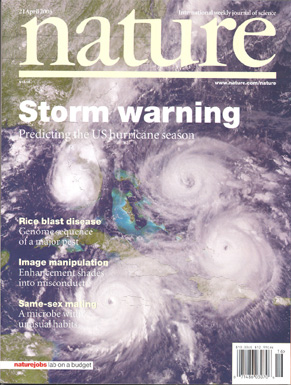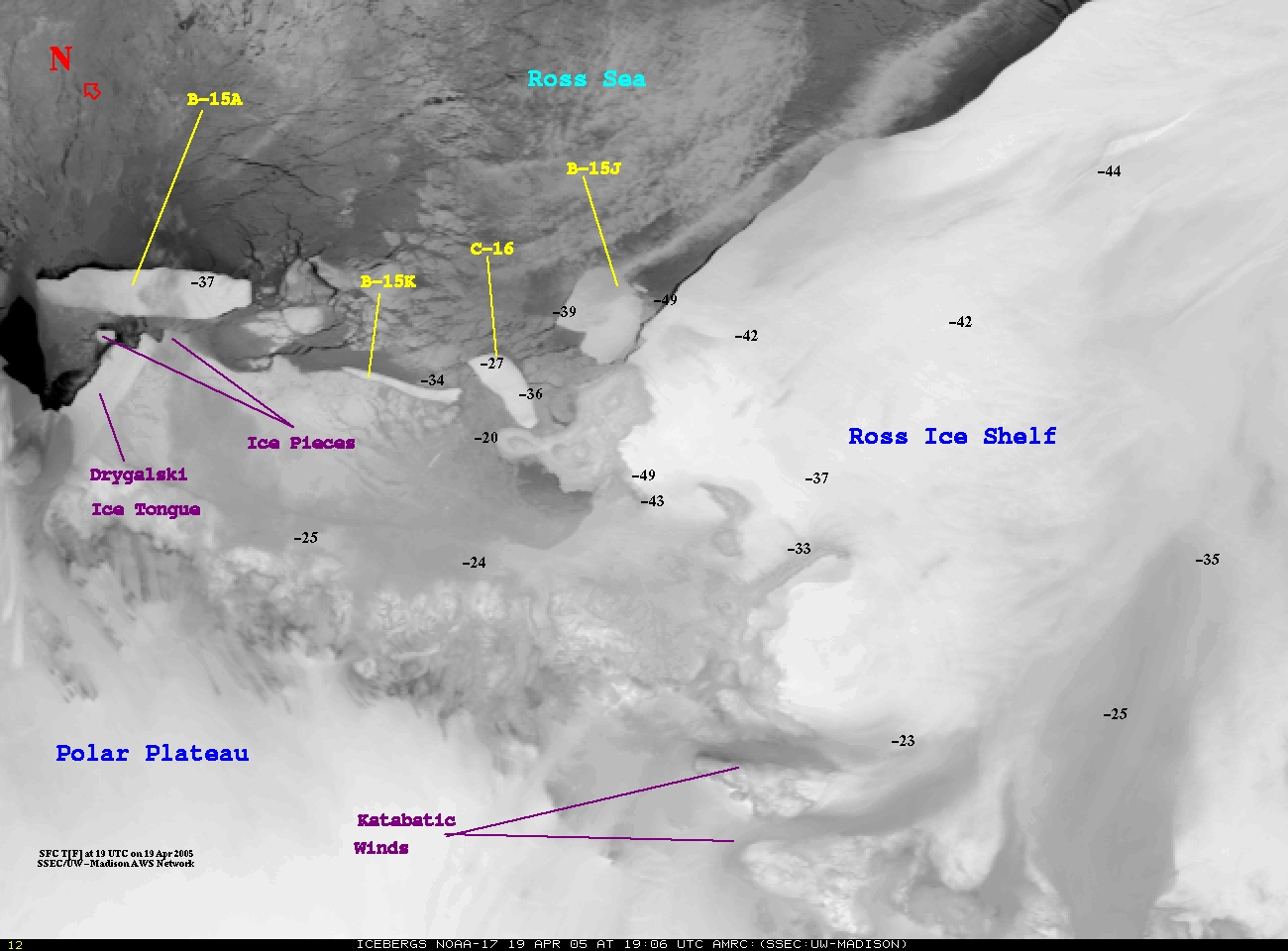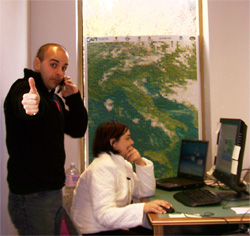Monthly News Summary – May 2005
Data and Imagery
 |
|
Rick Kohrs’s montage of major hurricanes in summer 2004 made the cover of nature.
|
On nature’s cover : The cover of the April 21 edition of naturefeatures Rick Kohrs’smontage of Hurricanes Charlie, Frances, Ivan and Jeanne. The articleassociated with the image discusses potential forecasting methods that are based on an analysis of wind anomalies from 1950-2003. The magazine credits the image to SSEC. The online version of the magazine also prominently displays the image. Kohrs used satellite imagery to produce the montage.
Hurricane hazards : Lee County, Florida recently produced the 2005 edition of their All Hazards Guide. The cover features Rick Kohrs’smontage of the major hurricanes that hit during the 2004 season.This is the same montage featured on the cover of nature magazine.
Cloud data useful for volcanic ash monitoring : Earlier this month, Mike Pavolonis (CIMSS) and Andrew Heidinger (NESDIS with SSEC) met with NESDIS scientists to discuss the possibility of using data from aCIMSS cloud product to identify volcanic ash and determine heights of ash plumes. The algorithms from the CLAVR-x Extended Clouds data that Pavolonis and Heidinger presented for these purposes appear effective for many events resulting from volcanic eruptions.
Linked : Larry Landon recently added a link to SSEC’s real time USA satellite composite image on his Grandfield Oklahoma Weather Cam Web site.
 |
|
This AMRC image, showing the Ross Ice Shelf, was featured with the Slate article.
|
Answering icy questions : An online news commentary, Slate, offers answers to common questions about the daily news in its explainer section. On April 20, writer Daniel Engber explored the question of what constitutes an iceberg versus a “bergy bit” and who counts them. Engber consultedMatthew Lazzara of SSEC’sAntarctic Meteorological Research Center (AMRC) for this piece. The article also links to AMRC’s iceberg FAQ as well as one of their iceberg images.
Presentations and Publications
International applications : From April 13-15, Tim Schmit (NOAA with SSEC) participated in a European conference to prepare for the next generation of meteorological satellites. Schmit, who helps guide the GOES-R development process, presented information on GOES-R and gave recommendations based on comments from GOES-R users’ conferences.
AIRS analysis : The January-February edition of NASA’s The Earth Observer included a synopsis of the meeting and mentioned Hank Revercomb and Bob Knuteson’s contributions. Revercomb and Knuteson attended the AIRS Science Team Meeting November 30 – December 2 and presented during the third session: Development of Advanced Product Generation Algorithms and Research Products. Knuteson studied the infrared surface emissivity over Egypt and presented his findings at the meeting. Revercomb showed results and preliminary data analysis from S-HIS flights to validate EOS Aqua and EOS Aura in October 2004. The synopsis mistakenly listed Knuteson as affiliated with the University of Washington.
CIMSS’s silver anniversary : This July brings the 25th anniversary of the SSEC’s Cooperative Institute for Meteorological Satellite Studies (CIMSS). The institute was founded in 1980 as an agreement between the National Oceanic and Atmospheric Administration and the University of Wisconsin-Madison with. NASA later joining the agreement. In conjunction with anniversary festivities, a symposium on “Satellite Meteorology: Past, Present and Future” will be held on the UW-Madison campus from 11-13 July 2005. The symposium will acknowledge many of the exciting advancements in satellite meteorology over the past quarter century that the institute was involved in, including their impact on weather and climate studies. CIMSS has been and continues to be a leader in the development of techniques and applications of environmental satellite data.
Anniversary buzz : As the CIMSS 25th anniversary nears, members of the scientific community continue to come forward and show their appreciation. Recently, Steve Lyons, a hurricane expert at the Weather Channel, gave glowing praise for CIMSS’s satellite work. He uses their satellite data in his forecasts and “beat[s] all the [numerical prediction] models on a routine basis.” Lyons extended his congratulations on 25 years of research and hard work. He added, “Those of us able to use satellite information effectively know the true value of it.”
 |
|
MARS researcher Sebastiano Mucerino and communications director Federica Rossi (seated) in front of a poster that SSEC helped with.
|
Telecommuting for MARS:SSEC’s public information coordinator Terri Gregorycontinues her adventures working for MARS in Benevento, Italy. Recently, she helped with a large technology trade show in Naples the weekend after Easter. For the Province of Benevento, MARS exhibited with a social services agency called MultiLabor. The image to the right shows Sebastiano Mucerino, one of the energy researchers at MARS, next to a poster announcing a 2004 meeting which SSEC co-organized.
